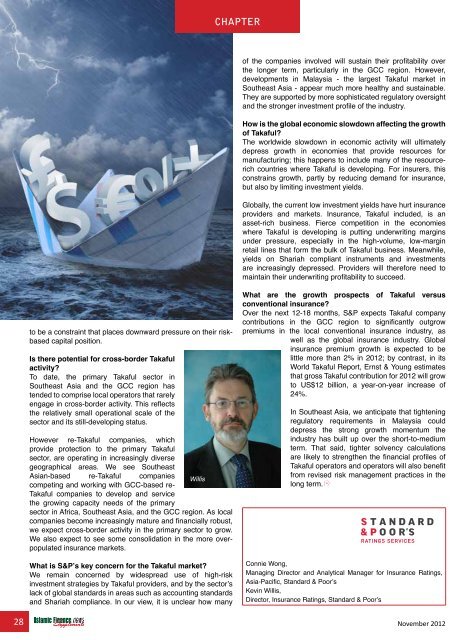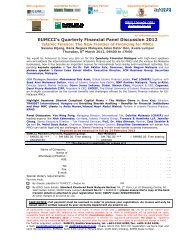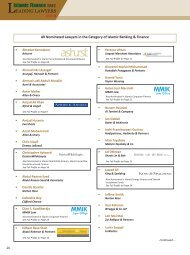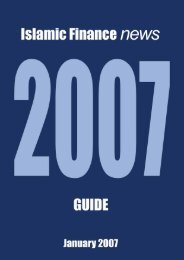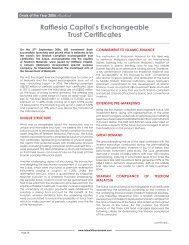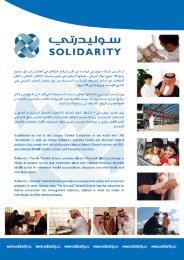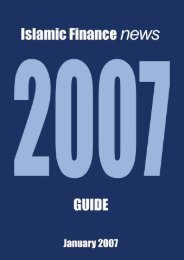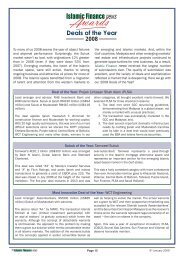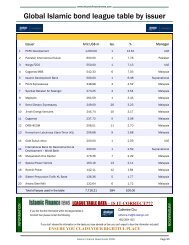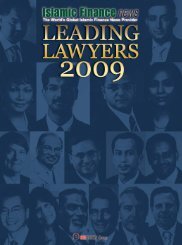Sukuk & Capital Market - Islamic Finance News
Sukuk & Capital Market - Islamic Finance News
Sukuk & Capital Market - Islamic Finance News
Create successful ePaper yourself
Turn your PDF publications into a flip-book with our unique Google optimized e-Paper software.
chapter<br />
of the companies involved will sustain their profitability over<br />
the longer term, particularly in the GCC region. However,<br />
developments in Malaysia - the largest Takaful market in<br />
Southeast Asia - appear much more healthy and sustainable.<br />
They are supported by more sophisticated regulatory oversight<br />
and the stronger investment profile of the industry.<br />
How is the global economic slowdown affecting the growth<br />
of Takaful?<br />
The worldwide slowdown in economic activity will ultimately<br />
depress growth in economies that provide resources for<br />
manufacturing; this happens to include many of the resourcerich<br />
countries where Takaful is developing. For insurers, this<br />
constrains growth, partly by reducing demand for insurance,<br />
but also by limiting investment yields.<br />
Globally, the current low investment yields have hurt insurance<br />
providers and markets. Insurance, Takaful included, is an<br />
asset-rich business. Fierce competition in the economies<br />
where Takaful is developing is putting underwriting margins<br />
under pressure, especially in the high-volume, low-margin<br />
retail lines that form the bulk of Takaful business. Meanwhile,<br />
yields on Shariah compliant instruments and investments<br />
are increasingly depressed. Providers will therefore need to<br />
maintain their underwriting profitability to succeed.<br />
to be a constraint that places downward pressure on their riskbased<br />
capital position.<br />
Is there potential for cross-border Takaful<br />
activity?<br />
To date, the primary Takaful sector in<br />
Southeast Asia and the GCC region has<br />
tended to comprise local operators that rarely<br />
engage in cross-border activity. This reflects<br />
the relatively small operational scale of the<br />
sector and its still-developing status.<br />
However re-Takaful companies, which<br />
provide protection to the primary Takaful<br />
sector, are operating in increasingly diverse<br />
geographical areas. We see Southeast<br />
Asian-based re-Takaful companies Willis<br />
competing and working with GCC-based re-<br />
Takaful companies to develop and service<br />
the growing capacity needs of the primary<br />
sector in Africa, Southeast Asia, and the GCC region. As local<br />
companies become increasingly mature and financially robust,<br />
we expect cross-border activity in the primary sector to grow.<br />
We also expect to see some consolidation in the more overpopulated<br />
insurance markets.<br />
What is S&P’s key concern for the Takaful market?<br />
We remain concerned by widespread use of high-risk<br />
investment strategies by Takaful providers, and by the sector’s<br />
lack of global standards in areas such as accounting standards<br />
and Shariah compliance. In our view, it is unclear how many<br />
What are the growth prospects of Takaful versus<br />
conventional insurance?<br />
Over the next 12-18 months, S&P expects Takaful company<br />
contributions in the GCC region to significantly outgrow<br />
premiums in the local conventional insurance industry, as<br />
well as the global insurance industry. Global<br />
insurance premium growth is expected to be<br />
little more than 2% in 2012; by contrast, in its<br />
World Takaful Report, Ernst & Young estimates<br />
that gross Takaful contribution for 2012 will grow<br />
to US$12 billion, a year-on-year increase of<br />
24%.<br />
In Southeast Asia, we anticipate that tightening<br />
regulatory requirements in Malaysia could<br />
depress the strong growth momentum the<br />
industry has built up over the short-to-medium<br />
term. That said, tighter solvency calculations<br />
are likely to strengthen the financial profiles of<br />
Takaful operators and operators will also benefit<br />
from revised risk management practices in the<br />
consulting www.<strong>Islamic</strong><strong>Finance</strong>Consulting.com<br />
www.<strong>Islamic</strong><strong>Finance</strong>Events.com<br />
long term.<br />
www.<strong>Islamic</strong><strong>Finance</strong><strong>News</strong>.com<br />
www.<strong>Islamic</strong><strong>Finance</strong>Training.com<br />
www.MIFforum.com<br />
www.MIFmonthly.com<br />
www.MIFtraining.com<br />
www.REDmoneyBooks.com<br />
Connie Wong,<br />
Managing Director and Analytical Manager for Insurance Ratings,<br />
Asia-Pacific, Standard & Poor’s<br />
Kevin Willis,<br />
Director, Insurance Ratings, Standard & Poor’s<br />
28 November 2012


